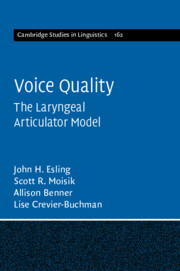Book contents
- Voice Quality
- Series page
- Cambridge Studies in Linguistics
- Voice Quality
- Copyright page
- Contents
- Figures
- Tables
- Preface
- Acknowledgements
- Abbreviations
- 1 Voice and Voice Quality
- 2 Laryngeal Voice Quality Classification
- 3 Instrumental Case Studies and Computational Simulations of Voice Quality
- 4 Linguistic, Paralinguistic, and Extralinguistic Illustrations of Voice Quality
- 5 Phonological Implications of Voice Quality Theory
- 6 Infant Acquisition of Speech and Voice Quality
- 7 Clinical Illustrations of Voice Quality
- 8 Laryngeal Articulation and Voice Quality in Sound Change, Language Ontogeny and Phylogeny
- References
- Author/Artist Index
- Subject Index
1 - Voice and Voice Quality
Published online by Cambridge University Press: 21 June 2019
- Voice Quality
- Series page
- Cambridge Studies in Linguistics
- Voice Quality
- Copyright page
- Contents
- Figures
- Tables
- Preface
- Acknowledgements
- Abbreviations
- 1 Voice and Voice Quality
- 2 Laryngeal Voice Quality Classification
- 3 Instrumental Case Studies and Computational Simulations of Voice Quality
- 4 Linguistic, Paralinguistic, and Extralinguistic Illustrations of Voice Quality
- 5 Phonological Implications of Voice Quality Theory
- 6 Infant Acquisition of Speech and Voice Quality
- 7 Clinical Illustrations of Voice Quality
- 8 Laryngeal Articulation and Voice Quality in Sound Change, Language Ontogeny and Phylogeny
- References
- Author/Artist Index
- Subject Index
Summary
Terminology for voice quality is revised, particularly for the lower vocal tract. The concepts of ‘voice quality’ as the long-term, habitual postural settings in an accent and ‘voice quality’ as the vibratory, phonatory portion of speech are reconciled through the laryngeal articulator mechanism that explains how multiple configurational adjustments and vibratory elements are achieved in the lower vocal tract. The origins of voice quality theory are reviewed, and articulatory settings of the laryngeal mechanism, velopharyngeal opening, the tongue, the jaw, and the lips are reviewed. The descriptions from Laver (1980) are reinforced, connections to laryngeal articulation are made explicit, and the musculature responsible for each setting is outlined. New drawings of the mechanisms of the vocal tract provide a fresh perspective on articulatory movements and resulting auditory qualities. Pharyngeal/epiglottal articulations are remapped, and their status as laryngeal configurations is made explicit.
Keywords
- Type
- Chapter
- Information
- Voice QualityThe Laryngeal Articulator Model, pp. 1 - 36Publisher: Cambridge University PressPrint publication year: 2019
- 2
- Cited by

